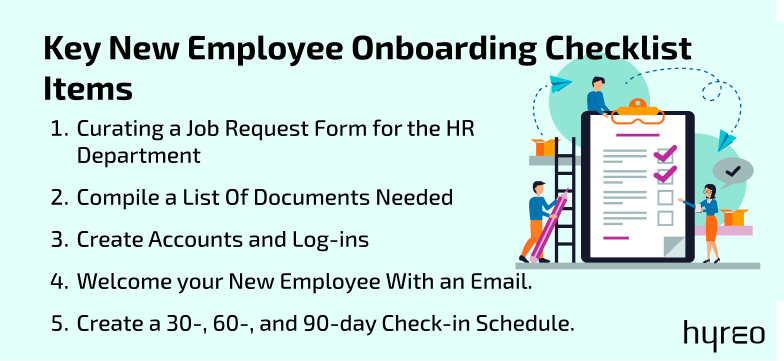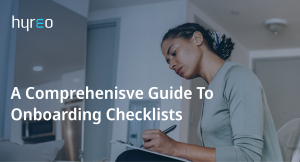Planning the onboarding process ensures smooth sailing for the company. Research by the Brandon Hall Group shows that organizations with a robust onboarding process see an 82% increase in new hire retention and a boost in productivity of over 70%.
The onboarding process comprises significantly more than simply ensuring that the recruit’s IT is set up and their HR documentation is done. If not done correctly, this may be an intimidating experience for both the recruit and the recruiter. Fortunately, you can plan and create the perfect new employee checklist.
The checklist ensures each crucial stage of the recruit’s onboarding process is covered. It serves as the foundation for job-specific processes. A recruitment onboarding checklist is a reference document that fulfills two purposes.
For starters, it ensures that new employee comprehends what is required of them. Second, it guarantees that no crucial tasks are overlooked during an employee’s initial encounters.
Let’s examine what a recruiting checklist should contain, why it is important, and how it might help your new employee orientation process.
Why Is a New Hire Checklist Important?
A good onboarding process is crucial since it acquaints workers with their roles, the firm’s beliefs, and what the organization offers. It also motivates employees by giving them the feeling that they’re a part of the team.
As the workforce becomes increasingly decentralized, onboarding processes have become slightly difficult.
The main goal is to attempt to attract in-demand talent, foster a feeling of belonging, and build connections that will aid in the acceleration of on-the-job learning without being in the same place as the other staff.
To accommodate these aspects, checklists ensure that the project flow is not compromised by minor adjustments.
Provided merely having a checklist does not guarantee an effective onboarding process. Nevertheless, it is a tool that may properly integrate a recruit into your company culture.
An inefficient onboarding process is a primary cause for up to 68% of employees leaving shortly after three months. Use checklists consistently for better results during onboarding. One can improve and improvise the same based on recruit experience and feedback.
What Should a New Hiring Onboarding Checklist Contain?
Irrespective of on-site or remote work modes, several aspects of the employment process demand a procedural checklist to be followed by team handlers. Onboarding is a complete, planned procedure that may last up to a year. One must realize that just having a new hire checklist template does not imply that onboarding should be handled as a ‘check-the-box’ task.
Key New Employee Onboarding Checklist Items

Here is a 12-step guide to consider concerning the onboarding checklist.
#1 Curating a Job Request Form for the HR Department
Before recruiting, submit a job requisition paper to your company’s human resources department for approval. Before a new employee is formally employed, the HR staff may additionally demand a completed background investigation and drug test. Close the available position and delete any employment advertising that is still active.
#2 Compile a List Of Documents Needed
Compile all of the documentation that the recruit will need to fill up on their very first day, including tax forms, agreements, payment details, and other recruitment forms.
#3 Check if the Employee Desk Has All the Particulars (Equipment and Tools)
Request all gadgets and equipment to arrive a few days ahead of time to ease into the new hire’s employment process. Everything from the employee’s computer system to uploading company software are well integrated and ready to go the moment they arrive.
#4 Create Accounts and Log-ins
Contact your IT department, facilities management, and finance department to ensure that the employee is registered in all relevant departments. Additionally, this allows the new recruit to have all of the necessary assets to access these premises. Set up their corporate email and gather their login details for different platforms and apps so they don’t have any difficulty accessing the programs and software they need to conduct their jobs.
#5 Prepare the Workstation
Ensure that your new hire has a clean and tidy desk-chair ensemble, as well as any additional items they require at their workspace. To make a welcome package for their workstation, collect company-branded items, office supplies, or a modest present like a mug or tiny plant. Consider delivering a box of goodies to the employee’s home address if they will be working remotely.
#6 Arrange for New-hire Orientation.
Schedule an orientation for new hires for the employee’s first day. Ideally, this will allow the employee not just to sign documents, but also to understand the company’s culture, see the organizational chart, and discover how different departments operate.
#7 Welcome your New Employee With an Email.
Send an email to your recruit before their first day to invite them to the organization and present them with key information about what they may anticipate when they arrive.
#8 Give an Office Tour
If your company has a physical site, show your new employee around and introduce them to important individuals in each area. Give them a sketch of the premises so they can find their way around with ease. Make a point of indicating the whereabouts of restrooms, break rooms, and other communal facilities. This is also an excellent moment to give your new employee their access key or passcode and go over company policies concerning security measures.
#9 Appoint a Peer Buddy
Introduce your recruit to a departmental peer or partner who may function as a buddy during their initial few weeks on the job. This individual will be prepared to respond to queries, introduce the worker to fellow workers in the department, and even assist in training them on particular elements of the position.
Having a buddy is vital to the success of a recruit since it can keep them from feeling isolated as they negotiate their new career in an unfamiliar setting.
#10 Send a Welcome Email to the Team
Send a new employee an announcement email, or share the news of their arrival during a business meeting to welcome the new worker to the team. Inform your current staff about the new hire’s role and provide some fascinating information to help establish a rapport.
#11 Make Time for Onboarding Review
Arrange a meeting with the new employee following their first two weeks to see how they’re coping and if they have any suggestions for the onboarding process. Such conversations may reveal areas for improvement in your onboarding process or extra items to include on the checklist.
#12. Create a 30-, 60-, and 90-day Check-in Schedule.
Schedule frequent check-ins with the recruit in a periodical manner, such as, after their first, second month, and first quarter. These sessions should provide a chance for employees to voice issues or reasonable criticisms regarding their training. It grounds a space to assess how well they are adjusting to their new job. In response to changing demands or employee input, you may opt to update and alter your onboarding checklist. Implementing a well-structured new employee checklist helps ensure a pleasant and satisfying experience for the new team member.
Checklist for Onboarding New Hire
Particulars of the Pre-onboarding Checklist
- Obtain a signed letter of job acceptance.
- Send a welcoming email to the new hire.
- Send a welcome package if you are telecommuting, or prepare one to be handed in, on the first day.
- Send an internal email notifying the arrival of the new employee and guaranteeing a warm reception.
- Plan ahead-of-time meetings with essential team members.
- Obtain request access to the office and network.
- Purchase computer hardware and an office phone.
- Create a dedicated workspace.
- Enrol the employee in the human resources system.
- Send employee paperwork that they may fill out ahead of time.
Particulars of Checklist for First-day Orientation
- Organize a tour of the workplace to introduce the employee to the team and management.
- Show them around their office and offer them a welcome kit.
- Assist them in getting everything set up
- Schedule a face-to-face with them at the end of the day to confirm the first day went well.
- Fill out new hire papers
- Give them the employee manual.
- Examine your timetable and working hours.
- Describe your compensation and perks.
- As needed, explain trip booking procedures and spending regulations.
Particulars of Checklist for the First Week
- Assign introductory tasks to the employee.
- Check-in with them every day to make sure they’re settling in.
- Set goals based on staff performance evaluations.
- Examine the probationary term of the employee.
- Check that the employee’s equipment is operational and answer any related inquiries.
- Ascertain that the individual has met with essential colleagues.
- Invite the employee to join any of the company’s social media profiles.
Particulars of Checklist for the First Month
- Keep providing frequent feedback.
- Inquire about the employee’s comments.
- Examine previous assignments.
- Examine forthcoming assignments.
- Ensure that the employee is receiving training on time.
- Check that employee’s paycheck is being processed correctly.
- To keep employees interested, schedule regular meetings or video meetings.
Particulars of Checklist After Three Months
- Schedule a casual performance evaluation
- Examine previous and upcoming assignments.
- Set performance objectives.
- Give and receive feedback.
- Examine the employee’s training progress.
- Discuss the probationary period’s end.
Particulars of Checklist After Six Months
- Do a performance evaluation.
- Examine the employee’s objectives and progress to date.
- Determine your targets and goals for the following six months.
- Confirm that the individual has obtained the necessary training.
Particulars of Checklist After a Year
- Do an annual performance evaluation.
- Commemorate their first year with the firm.
- Discuss the future year’s goals, projects, and plans.
- Respond to any queries and provide/receive comments.
- Discuss compensation and policy changes.
Key Takeaways
A comprehensive new onboarding checklist can keep your team organized and provide a seamless onboarding process, ensuring sustainability and increased efficiency. A new hire checklist may help in making a favorable first impression.
Onboarding checklists ensure that all aspects are fulfilled during employee onboarding and that nothing goes in vain.
Also Read:
Employee Benefits Plan: Meaning, Advantages, & Strategies
11 Strategies to Implement to increase employee productivity and raise morale
FAQs on Employee Checklist
What exactly is a new hire checklist?
A new hire checklist aids in the integration of employees into a company. It is a tool that assists you in successfully integrating a recruit into your organization, culture, and job.
What is the significance of an onboarding checklist?
A recruit onboarding checklist is a guidance document that serves two functions. For starters, it ensures that they acknowledge what is expected from them. Second, it ensures that companies do not neglect any proactive steps during an employee’s initial few days, weeks, or months on the job.
What is the purpose of new hire onboarding?
Onboarding is critical since it acquaints workers with their roles, the firm’s beliefs, and what the organization has to offer. It also inspires employees to craft dedicated workers out of themselves and aids in the retention of new hires by treating them like a part of the team.
How to create an onboarding checklist?
1. Examine the role’s requirements.
2. Make sections in the checklist.
3. Make a list of pre-hire requirements.
4. Determine their first day’s tasks.
5. Determine their tasks during the first week.
6. After their first month, follow up with them.
What are the advantages of efficient onboarding?
1. Improved employee experience.
2. Increased employee involvement.
3. Improved staff retention.
4. Talent attraction is made easier.
5. Improved business culture.
6. Increase in productivity.




